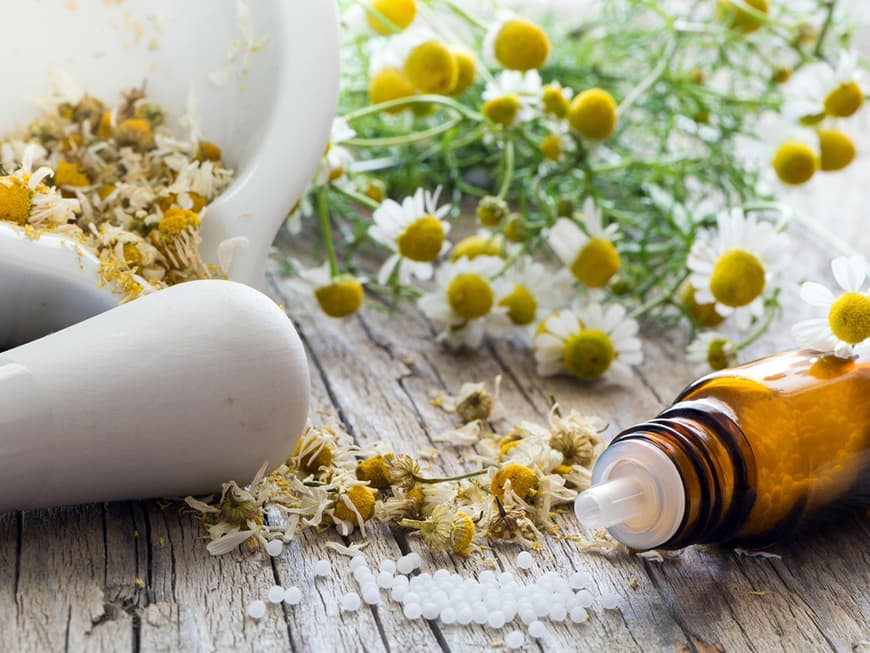
- Different areas of application for chamomile
- The effect of chamomile when used externally
- What you should bear in mind when using camomile
Different areas of application for camomile
Chamomile can be used in a wide range of applications. It is mainly the flowers and the essential oil obtained from them, which is characteristically blue in color, that are used. Chamomile is mainly used to relieve cramps, promote wound healing and reduce inflammation. It also has an antibacterial and antiflatulent effect. The following illnesses can be treated particularly well with chamomile:
- Urinary tract infections
- flu
- Gastrointestinal complaints
- Skin rash
- Poorly healing wounds
- Inflamed skin
- Bacterial skin diseases
Its antispasmodic effect can also alleviate menstrual cramps. Chamomile is also said to have a calming effect, which is why it is often used to improve the quality of sleep.
The effect of chamomile when used internally
If oral intake is necessary, for example in the case of a gastrointestinal or urinary tract infection, you can make a tea from the chamomile flowers. To do this, pour 150 ml of boiling water over 3 g of chamomile flowers, which corresponds to approximately one teaspoon. This brew should steep for about 10 minutes and then be separated from the flowers using a sieve. In order for the tea to develop its full effect, you should drink about three to four cups of the freshly prepared tea every day.
The effect of chamomile for external use
In some cases it makes sense to use chamomile externally. The plant not only acts on the surface of the skin, but can also penetrate into deeper layers of the skin and also increase the absorption of other medicinal substances. The external application is particularly suitable for bacterial or inflammatory skin diseases, rashes or open wounds, but can also provide relief in the form of a sitz bath for a urinary tract infection. For such sitz baths, you should mix approximately 5 g of flowers or 0.8 g of extract with one liter of hot water in a bowl suitable for sitz baths. Alternatively, you can also add an appropriate amount of the mixture to the bathtub.
For compresses, rinsing or gargling solutions, you should mix 3-10 g of chamomile flowers with 100 ml of hot water and apply to the relevant areas daily, or use for a few minutes to gargle and rinse inflamed areas in the mouth. As the mucilage in chamomile has a particularly anti-inflammatory and soothing effect on the mucous membranes and gums, it is usually effective here. For compresses, you should soak a washcloth or tear-resistant cellulose paper in the infused tea and then apply it to the affected area while it is lukewarm, but not too hot. Chamomile is also ideal for inhalation, for example in the case of a flu-like infection with sinusitis. To do this, mix about 5 g of chamomile flowers or 0.8 g of extract with a liter of hot water. This mixture can either be placed in an inhaler or in a bowl for inhalation. You can change the quantity as required, but the ratio of flowers or extract to water should remain the same.
In addition to these effects as a natural medicinal plant, chamomile also has deodorizing and fragrant properties, which is why it is often used in body care products such as hand creams, shower gels or face wash lotions as well as make-up products. Due to its odor-reducing properties, chamomile has a positive effect on physical well-being and skin metabolism.
What you should bear in mind when using chamomile
In addition to the versatile areas of application in which the effect of camomile can provide relief, there are also a few aspects to bear in mind when using it. It is not recommended to use chamomile if you have previously been diagnosed with hypersensitivity to composite plants such as arnica, yarrow or marigold, as it is highly likely that this will also occur when using chamomile products. Hypersensitivity reactions have only rarely been observed when using chamomile. However, allergic reactions can occur due to a cross-reaction, which can occur when chamomile is contaminated with dog chamomile. When using chamomile externally, it is also particularly important that you do not use it around the eyes, as it very often has an irritating effect on the eyes.
Even if the effect of chamomile is a successful alternative to conventional medicine in many areas, it is important that you also consult a doctor if you have prolonged symptoms that last longer than a week or if symptoms keep recurring.
